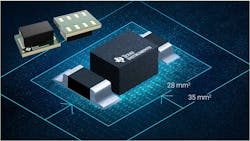Members can download this article in PDF format.
Engineers have many options when designing power stages, from low-dropout (LDO) regulators to switching power supplies. The former provide low noise and ripple for sensitive circuit elements, but the latter deliver the efficiency and power density often required to remain competitive in today’s marketplace.
Unfortunately, switching power supplies require bulky inductors or transformers that typically require shielding, and they can be difficult to fit within the mechanical constraints of your design. In addition, inductors and transformers may be difficult to source. As an alternative, you can choose a power module that integrates the required inductor or transformer within the switching-regulator package.
Power-Module Types
Power modules come in industry-standard leaded and no-lead packages, or they can incorporate Texas Instruments’ embedded microsystem-in-package (µSiP) or new MagPack packaging technologies. Leaded packages include an IC mounted between two copper leadframes with passive components on top. These commonly used packages make layout intuitive, with their visible leads helping to ensure solder integrity while offering about 8 mm of creepage clearance—and they facilitate debug. However, they generally require large amounts of printed-circuit-board real estate.
Alternatives include quad-flat no-lead (QFN) packages, which make connections to a board via flat pads instead of leads. They come in open-frame or overmolded configurations, with the overmolded versions incorporating conventional copper leadframes in thermally enhanced plastic packages.
One example of an overmolded QFN device is TI’s TPSM64406 high-density power module, which accepts a 36-V input and delivers dual outputs of 3 A each or a single output rated at 6 A. This device includes passive components mounted directly on top of the leadframe, offering improved thermal and electrical performance compared with leaded devices.
A good packaging choice for designs with very limited board space is the embedded µSiP, which includes a converter IC integrated within a substrate that has the passive components mounted on top. One such example is TI’s TPSM83100 5.5-V, 1-W buck-boost module. It offers bidirectional current operation, making it suitable for use in battery-backup systems. It comes in a 2.5- × 2.0- × 1.2-mm package (Fig. 1).
Integrated Magnetic Packaging
A third packaging option employs TI’s MagPack integrated-magnetic packaging technology. The company reports that MagPack modules offer better thermal conductivity and lower levels of electromagnetic interference (EMI) than do other packaging technologies. Moreover, they eliminate the need to rely on third-party suppliers for inductors and transformers.
TI cites several benefits of MagPack technology, the first being high power density and, hence, smaller solution size for a given power rating. For example, the TPSM82866A MagPack module with integrated inductor can deliver up to 6 A at up to 5.5 V from a package with a 2.3- × 3-mm footprint—the smallest size of any 6-A power module on the market, according to the company.
Also, TI’s TPSM82816 adds features such as clock synchronization as well as adjustable soft-start, clock frequency, and control-loop compensation in a slightly larger 2.5- × 3-mm footprint.
In addition, MagPack modules offer high efficiency. With MagPack technology, TI matches the inductor to the silicon technology, minimizing both AC and DC losses. Then it employs a high-conductivity package to efficiently remove the heat due to the remaining losses. Figure 2 shows the efficiencies that the TPSM82866A MagPack module can achieve across a range of voltages and currents.
A third benefit is reduced EMI, because MagPack doesn’t just shield the inductor—it encloses the entire die, inductor, and switching node in a shielded package. Figure 3 illustrates preliminary EMI emissions curves in accordance with relevant Comité International Spécial des Perturbations Radioélectriques (CISPR) standards (with emissions limits shown as dashed lines) for a version of the TPSM82866A without MagPack technology. You can see that between 500 and 600 MHz, levels for horizontal and vertical polarization reach 38 and 36 dB, respectively.
Figure 4 shows the curves for a TPSM82866A with MagPack technology. For the peaks near 500 MHz, you can see that MagPack technology reduces peak emissions with horizontal polarization by about 2 dB, and with vertical polarization, it reduces by about 8 dB.
In addition to the TPSM64406 and TPSM82866A, TI offers a variety of power modules with integrated inductors, including buck, boost, buck-boost, and flyback modules. The TPSM83102, for example, is a buck-boost converter in a µSiP module that delivers 1.5-A outputs at 1.2 to 5.5 V. It automatically operates in buck or boost mode depending on the input voltage, which can range from 1.6 to 5.5 V.
EVM Provides Development Assistance
TI offers development assistance to help you get started with its power modules. For example, the TPSM82866CA3PEVM evaluation module (EVM) can help in the assessment of typical step-down converter designs based on the TPSM82866C MagPack power module.
The TPSM82866C is similar to the TPSM82866A but adds an I2C interface that can adjust the output down to 0.8 V at 1% accuracy. To enable your computer to talk to the I2C interface by way of the EVM, you will need TI’s USB2ANY interface adapter, which supports SPI in addition to I2C. The adapter also supports a GUI for the EVM.
With the EVM, you’re able to evaluate a variety of operating characteristics. For example, you can inject an AC signal (TI recommends 10 mV p-p) into the EVM’s control loop to perform loop-response gain and phase measurements across a frequency range of interest. You can also do thermal profiling. Figure 5 shows the thermal performance of the EVM operating with a 5-V input and a 1.2-V, 6-A output.
Conclusion
Power supplies are critical components of electronic products, but they can impose significant design challenges. Power modules with integrated inductors can help you achieve compact designs with excellent thermal performance and low emissions. TI offers EVMs to get you started.





